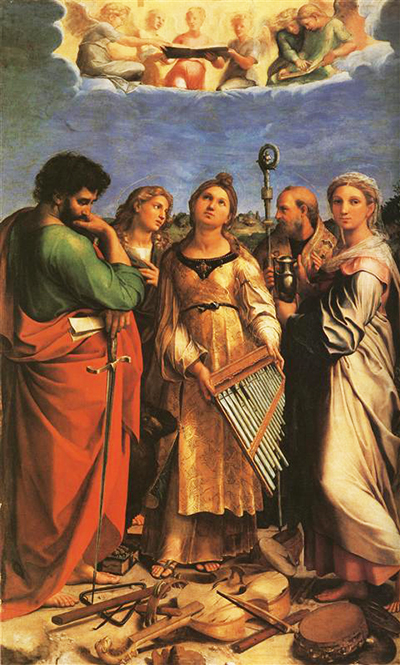The oil painting of St Cecilia by Raphael never fails to amaze people. He completed the painting in 1516-1517, and Cardinal Lorenzo Pucci paid for the work to act as a centrepiece for the Bolognese church.
It portrays the patroness of musicians, St Cecilia, clothed in gold and charmed by the choir of the angels. On her side are Mary Magdelene, Augustine and John the Evengalist and St Paul. St Paul is on the left side clad in a massive red cloak and leaning on a sword. He looks to the broken instrument at St Cecilia's feet as he clasps a letter with inscriptions.
John the Evangelist is standing next to St Paul and on the right is Mary Magdelene. Mary Magdalene looks out while holding her trademark oil ointment which she carried to Jesus's tomb. She is next to St Augustine who looks towards St John and clearly, the two appear engaged in a conversation. In this painting, the figure of St Augustine plays a vital role as he was the patron of the religious order who recognised music as a path to God.
One of the reasons this painting is memorable is because St Cecilia was not portrayed as appropriate and heavenly. Instead, she is depicted as a singing saint who is in a trance, with a musical instrument broken at her feet. All the same, St Cecilia by Raphael is one of the few art pieces the artist completed on his own at a time he was engaged with many duties like designing tapestries, overseeing archaeological digs, and serving as an architect.
St Cecilia by Raphael is painted using the style of Sacra Conversazione. This genre comes from the Italian High Renaissance, and it is based on sacred/holy conversations. Most of the art pieces under this genre have depicted the Virgin and the Child although earlier compositions were rigid and different. The style is inspired by saints looking at each other while engaging in conversations. For instance, St Augustine and St John look towards each other while engaging in a conversation.
The central idea behind this painting is a glorification of purity through the depiction of figures that symbolise different meanings. St Cecilia by Raphael contains a lot of figurative elements to achieve the style of sacra conversazione. As a result, the painting is unique, and it continues to amaze many people who have come across it.
Elena Duglioli dall'Oglio commissioned the altarpiece in 1514. She was a wealthy mystic lady who lived in Bologna in the family chapel in the church of San Giovanni. St Cecilia by Raphael was brought to Paris in 1973 in the form of a canvas. Later, it was returned to Italy in 1815, and now the painting is located at National Painting Gallery. Unluckily, St Cecilia by Raphael is in poor condition due to some of the damages the painting has undergone over the years.




